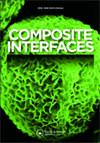Interphase characterization of glass/epoxy composite using peridynamic method and micro tensile test
IF 2.4
4区 材料科学
Q3 MATERIALS SCIENCE, COMPOSITES
引用次数: 2
Abstract
ABSTRACT In this paper, a novel procedure is developed to characterize the interphase region using the nonlocal peridynamic method and micro tensile tests of glass/epoxy specimens with a single fiber of glass. For this purpose, micro tensile tests are performed by an accurate tensile test device and high-quality camera imaging for data sampling. The obtained displacements are analysed by the image processing method and used as target values in the peridynamic analyses. Multiscale mass points from macro to micro scale are generated to model the interphase region in single fiber specimens using the state-based peridynamic method. With the coupling of peridynamic and multivariate optimization codes, the program is automatically executed by the prediction of thickness and elastic modulus of interphase to achieve the desired displacements similar to micro tensile test results. In this innovative method, unlike nanoindentation tests, where the results are limited to a specific section or point, the interphase characterization gives an overall elastic modulus value along the examined length of the sample. The obtained results from the presented procedure show that the interphase elastic modulus is between 20.8 and 28.86 GPa and the interphase thickness is between 1.149 and 1.986 microns. The obtained results are in the range of nanoindentation tests results presented in the literature, and the difference could be due to the manufacturing conditions, epoxy properties, and quality of the fiber silane coatings. GRAPHICAL ABSTRACT玻璃/环氧复合材料的界面相特性研究
本文提出了一种新的方法,利用非局部周动力学方法和单纤维玻璃/环氧树脂试样的微拉伸试验来表征相间区域。为此,微拉伸试验由精确的拉伸试验装置和高质量的相机成像进行数据采样。通过图像处理方法对得到的位移进行分析,并将其作为周动力分析的目标值。采用基于状态的周动力学方法,生成了从宏观到微观的多尺度质量点来模拟单纤维试样的相间区。通过对界面厚度和弹性模量的预测,通过动态和多元优化代码的耦合,自动执行程序,实现与微拉伸试验结果相似的期望位移。在这种创新的方法中,与纳米压痕测试不同,纳米压痕测试的结果仅限于特定的部分或点,界面表征给出了沿样品检测长度的总体弹性模量值。所得结果表明,相间弹性模量在20.8 ~ 28.86 GPa之间,相间厚度在1.149 ~ 1.986微米之间。所获得的结果在文献中提出的纳米压痕测试结果的范围内,差异可能是由于制造条件,环氧树脂性能和纤维硅烷涂层的质量。图形抽象
本文章由计算机程序翻译,如有差异,请以英文原文为准。
求助全文
约1分钟内获得全文
求助全文
来源期刊

Composite Interfaces
工程技术-材料科学:复合
CiteScore
5.00
自引率
3.80%
发文量
58
审稿时长
3 months
期刊介绍:
Composite Interfaces publishes interdisciplinary scientific and engineering research articles on composite interfaces/interphases and their related phenomena. Presenting new concepts for the fundamental understanding of composite interface study, the journal balances interest in chemistry, physical properties, mechanical properties, molecular structures, characterization techniques and theories.
Composite Interfaces covers a wide range of topics including - but not restricted to:
-surface treatment of reinforcing fibers and fillers-
effect of interface structure on mechanical properties, physical properties, curing and rheology-
coupling agents-
synthesis of matrices designed to promote adhesion-
molecular and atomic characterization of interfaces-
interfacial morphology-
dynamic mechanical study of interphases-
interfacial compatibilization-
adsorption-
tribology-
composites with organic, inorganic and metallic materials-
composites applied to aerospace, automotive, appliances, electronics, construction, marine, optical and biomedical fields
 求助内容:
求助内容: 应助结果提醒方式:
应助结果提醒方式:


